How I “Made” My Kids Love Water
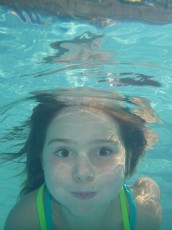
It’s summer again, and the city pool is open and filled with splashing kids. Next to me is a mom wrestling a panicked child who seems convinced that she is trying to drown him; he is screaming, terrified, and refusing to get even one toe in the water. She finally lets him go and he runs away.
My kids are the opposite. They’re under the water more than they are above it, making it impossible to tell them it’s time to go. They leap off the diving board alone and without fear, yelling “Don’t catch me!” and warding off concerned lifeguards. June is 7 and Rory is 5, and they’ve been swimming for years.
So why are my kids bobbing around like happy human corks while others are scared to death to bathe? I’m no expert, but I’ll tell you what we did differently.
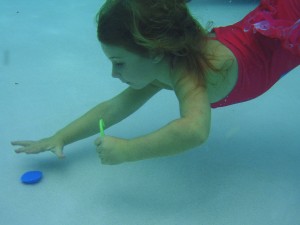
June was diving for pocket change in the 5-ft deep area by age five, and over this winter she spontaneously started free diving in the deep end because she saw a hair tie on the bottom (about 10-12 feet down.) Her nickname when she takes swim lessons is “Miss Fish.” Rory wants to do everything June can do and she’s catching up fast. She’s getting the hang of diving down instead of staying on the surface. They both swim with their faces in the water, have masks and snorkels and know how to use them. I put them in swim lessons so they will learn actual strokes like the crawl and the sidestroke, but they find their way through the water by instinct.
It started when they were babies. When you have a baby in the hospital a nurse usually does the first bath, using just enough water to get them wet and sponging it over them in an air conditioned room. To me it seems like common sense that this is no fun and it’s not going to create any love of the water; if I put you into two inches of water in a tub would that be comfortable or relaxing?
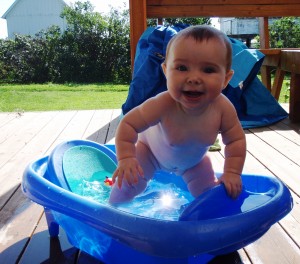
When an adult bathes they sink into a tub full of warm water and relax, and children like the same thing. A baby tub full to the brim will be splashed out and make a mess, so it’s best to keep it in the big tub instead of the kitchen sink, or in the summers we put it outside on the porch.
Of course having a baby in water up to their neck is not the safest way to bathe them; I always, ALWAYS kept one hand on my baby’s chest when they were in the water to make sure they were upright and safe. Even when they were toddlers I didn’t leave them alone; part of having fun in the water is feeling safe, for them and for you.
We also took our babies in the shower with us pretty often. The water would splash them in the face and we’d rinse them under the spray. We never shielded their faces when we rinsed their hair, we just told them to close their eyes. They learned to hold their breath and that water in the face is not a big deal, and they still really like hot showers, just like their parents do. See the simplicity of this approach? When it comes to water if you like it, they probably will, too.
After bathing comes swimming. I knew it would be next to impossible to keep them out of the water, and sooner or later they would be likely to get in over their heads. So what do you do to keep a water-loving child safe? Teach them to swim as early as possible.
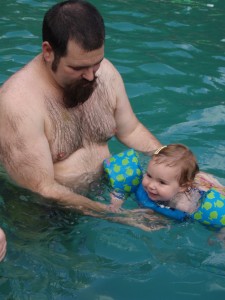
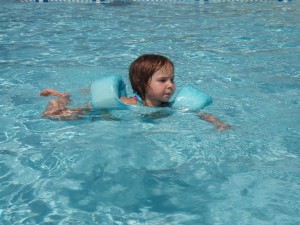
As babies and toddlers they had “floaties,” life vests with arm and chest floatation that allowed them to move and kick. It was important that they not be simply held up but be able to move, and encouraged to do so. We took them in water over their heads and they had to learn to kick their legs to keep up as we moved around-the first step to swimming.
I wanted them to be able to at least doggie-paddle so if they did get over their heads they would be able to get back to safety. I also taught them to float on their backs as a way to rest safely in the water. They all had both skills down by age 4, but such a small child working hard to paddle to the side terrified people and we were always reassuring the white-faced lifeguards. We also stayed right with them even when they were competent swimmers to protect them from bigger kids in the pool or moments of panic if they got scared. And to reassure other adults that these tiny swimmers were really okay.
When we took our girls to Cozumel last year Rory was 4 years old and June turned 6 while we were there. Our oldest, Chenoa, was 16 and a strong swimmer; she spent half her time standing on her head underwater to look at the fish. To prepare them we all went to the YMCA pool 3 or 4 times a week and used their salt water pool for about 3 months before the trip. They practiced with snorkels and masks so they would be prepared for the reefs, and June proved to be a good snorkeler. Rory was not interested in fish, being intent on building sand castles everywhere we went, and that’s okay too. We kept life jackets on them in the ocean because Cozumel has strong currents, but the time that we spent preparing in the pool at home meant that they were strong swimmers and unafraid of splashing waves.
So I never “made” my kids like the water, I just didn’t keep them out of it. Red Cross swim lessons don’t start until age 5, but if you wait until then to get into the water regularly it’s scary and unfamiliar. A strong swimmer and water person myself I wanted my children to be able to share my love of the ocean, so I shared it with them from the day they were born.
Above all I want my children to be safe in the water. If you’re going to have a pool or live by a body of water someday your kids are going to get in when you’re not looking. I encourage everyone to get their kids into the water and teach them the basic safety, and then teach them to swim as early as you can. I’ve recently seen ads for an amazing training program for babies that teaches them how to flip over in the water and float while calling for help. Learning to swim isn’t about winning the Olympics, it’s about having the skills to survive. If we go somewhere unfamiliar or out on a boat we still wear life jackets; swimming doesn’t replace floatation when you’re caught in a current or an undertow.
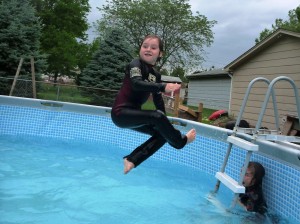
The simplest way to “make” your kids love the water? Put them in it-a lot! Keep them safe and show them that it’s fun by hanging out with them. We set up our above ground pool last week, our own backyard oasis. You know where you can find us!
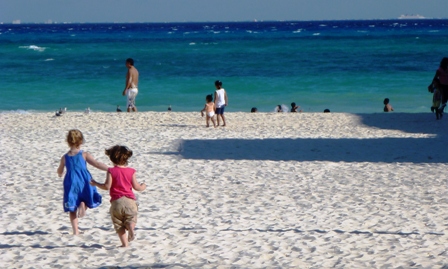



I was amazed and still am on how well the kids swim! Like little dolphins!
Me too! Rory is well on her way to diving, she wants to know when she can learn to scuba with us!